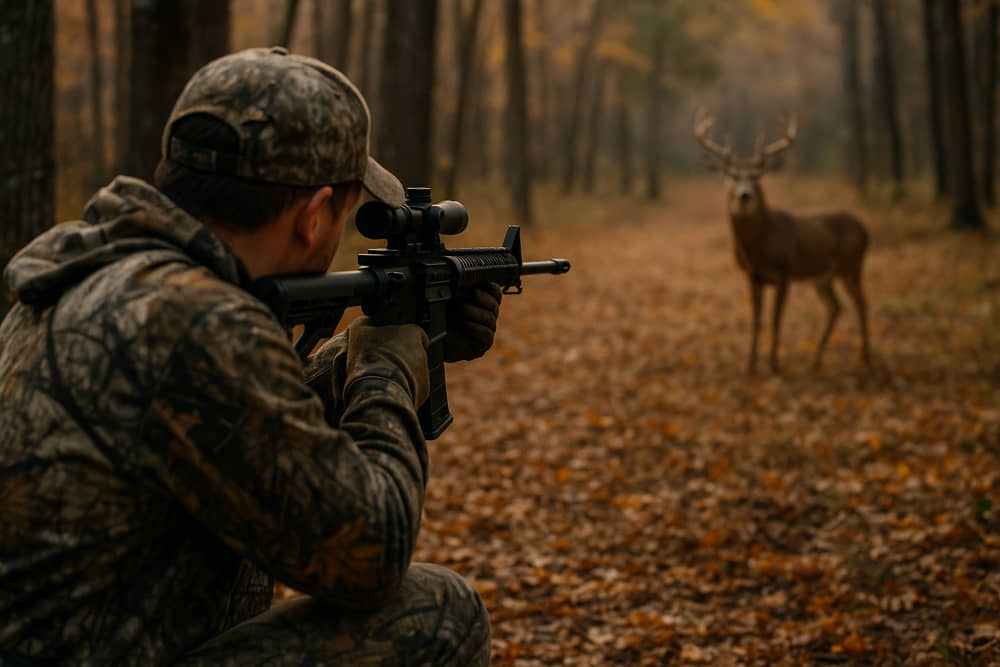Is a .223 really good enough for deer hunting, or is it simply too small to get the job done? This question sparks constant debate among hunters, especially those who are new to the sport or looking for a versatile rifle that can serve multiple purposes. The .223 Remington, widely known for its accuracy and affordability, has long been a favorite for target shooting and varmint hunting. But when it comes to whitetails and other deer species, opinions quickly divide.
For many hunters, the appeal of the .223 lies in its light recoil, low cost, and impressive precision, making it an excellent training and practice caliber. However, critics argue that its limited stopping power and smaller bullet size raise ethical concerns. Nobody wants to wound a deer and watch it escape into the woods, suffering instead of being harvested cleanly.
So where does the truth lie? Can the .223 be used responsibly for deer hunting, or is it better left for smaller game? In this article, we’ll break down the pros and cons of hunting deer with a .223, examine its effectiveness in real hunting scenarios, and compare it to more traditional calibers. By the end, you’ll know whether this cartridge deserves a place in your deer camp or not.
Table of Contents
Understanding the .223 Remington in Hunting
The .223 Remington is one of the most widely used cartridges in the United States. Originally developed in the 1960s, it became popular in both civilian and military applications. Today, it is most often seen in AR-15 style rifles and lightweight bolt-action hunting rifles.
For many hunters, the .223 has a strong appeal because of its accuracy and mild recoil. This makes it a great choice for beginners or those who practice frequently and want to stay sharp without spending too much money on ammunition. Its relatively flat trajectory also allows hunters to place shots with precision at medium ranges.
However, when it comes to deer hunting, the .223 is often considered a borderline option. The cartridge was designed for smaller game such as coyotes, prairie dogs, and other varmints. While it is capable of taking down a deer, it requires more discipline from the hunter. Proper shot placement becomes absolutely critical, as the small caliber does not forgive mistakes in the same way a larger round might.
This balance between convenience and limitation is what makes the .223 both attractive and controversial in the deer hunting community.
Advantages of Using a .223 for Deer Hunting
Despite the controversy, the .223 Remington does offer several advantages that make it a viable option for certain hunters and hunting conditions.
1. High accuracy
The .223 is well known for its precision. With minimal recoil, hunters can stay steady behind the rifle and place shots exactly where they need to go. For those who train regularly at the range, the accuracy of this cartridge can translate into cleaner kills in the field.
2. Low recoil for better control
Unlike larger calibers such as .308, the .223 produces very little kick. This makes it easier for beginners, youth hunters, or smaller-framed shooters to handle the rifle confidently. Reduced recoil also helps maintain accuracy when making quick follow-up shots.
3. Affordable and widely available ammunition
Cost is always a factor in hunting. .223 ammunition is among the most affordable centerfire cartridges on the market, allowing hunters to practice more often without breaking the bank. The more familiar a hunter is with their rifle, the better their performance will be in the field.
4. Effective with the right bullet selection
Modern ammunition technology has greatly improved the performance of smaller calibers. Hunters who choose bonded soft points, partitioned bullets, or solid copper rounds can achieve reliable penetration and energy transfer. This makes the .223 much more capable against deer than older generations of ammunition.
While the .223 is not a universal solution, these advantages explain why many hunters continue to consider it a legitimate choice for deer hunting under the right circumstances.
Drawbacks and Ethical Concerns of Using a .223
While the .223 has its advantages, it also carries significant drawbacks that fuel ongoing debate among hunters and wildlife managers.
1. Limited stopping power
The .223 simply does not deliver the same energy as larger calibers. Although it can kill a deer, the margin for error is very small. A poorly placed shot may not penetrate deeply enough to reach vital organs, increasing the risk of losing the animal.
2. Greater chance of wounding rather than a clean kill
Ethical hunting is about ensuring quick, humane harvests. With a smaller caliber like the .223, the likelihood of wounding a deer rises if shot placement is not perfect. This can result in unnecessary suffering and lower recovery rates, something no responsible hunter wants.
3. Legal restrictions
In many states across the U.S., regulations set a minimum caliber requirement for deer hunting. Some jurisdictions specifically prohibit the use of .223 or any caliber smaller than .24 for big game. Hunters must always check local laws before heading into the field.
4. Ethical debates among hunters
Even in states where it is legal, many hunters feel that using a .223 for deer is pushing the limits of responsible hunting. They argue that bigger calibers like .243 or .308 provide a greater margin of safety, ensuring a cleaner harvest and reducing the risk of prolonged suffering. Others counter that with the right bullet and precise shot placement, the .223 can be just as effective.
This ongoing debate shows why the .223 remains one of the most controversial choices in deer hunting.
When the .223 Can Be a Reasonable Choice
Although the .223 is not the first caliber most hunters reach for when pursuing deer, there are situations where it can be a practical and ethical choice.
1. Ideal for new or young hunters
Because of its light recoil, the .223 is easier to shoot accurately. For beginners who are still learning trigger control and proper aiming techniques, this can build confidence and improve consistency. A well-placed shot from a .223 is far more effective than a poorly placed shot from a larger caliber.
2. Effective at close to moderate ranges
The .223 performs best at distances under 150 yards. Within this range, hunters who know their rifle well can deliver accurate, lethal shots. Beyond these distances, energy drops quickly, and effectiveness becomes questionable.
3. Suitable for experienced hunters who respect its limits
Skilled hunters who understand shot placement and anatomy can make the .223 work effectively. They know when to pass up a shot and wait for the right opportunity rather than taking risky angles or longer distances.
4. A versatile rifle for multiple purposes
For hunters who already use a .223 for varmint or predator control, having one rifle that can also handle deer under the right conditions can be convenient. Instead of purchasing a separate caliber, they can use what they already own while staying within legal boundaries.
When applied with discipline and knowledge, the .223 can indeed be used responsibly for deer hunting. The key lies in understanding its limits and committing to ethical hunting practices.
Comparing the .223 to More Popular Deer Hunting Calibers
When deciding whether the .223 is suitable for deer hunting, it helps to compare it with calibers that are more traditionally trusted for this purpose. Two of the most common options are the .243 Winchester and the .308 Winchester.
.243 Winchester
The .243 has long been considered one of the best entry-level deer hunting calibers. It offers more energy than the .223 while still maintaining relatively light recoil, making it manageable for younger hunters. Its versatility allows it to handle both smaller varmints and medium-sized game like deer with confidence. Compared to the .223, the .243 provides a larger margin for error in shot placement, reducing the chance of wounding.
.308 Winchester
The .308 is a powerhouse caliber that has earned a reputation for reliability in the deer woods. With its heavier bullets and greater energy, it ensures quick, humane harvests at a wide variety of ranges. While its recoil is more noticeable than that of the .223 or .243, most hunters consider it a fair trade-off for the added effectiveness.
The Bottom Line
Both the .243 and the .308 give hunters greater confidence in achieving clean kills. While the .223 can work under ideal conditions, it sits at the very edge of what is considered effective for deer. For those who want a safer and more forgiving option, stepping up to one of the more traditional calibers is often the wiser choice.
Conclusion
So, is the .223 good for deer hunting? The honest answer is yes, but only under the right circumstances. With the proper bullet selection, careful shot placement, and within moderate ranges, the .223 can be an effective and ethical choice. Its accuracy, light recoil, and affordability make it attractive to both beginners and seasoned shooters.
However, hunters must also recognize its limits. Compared to calibers like the .243 or .308, the .223 leaves less room for error and carries a greater risk of wounding an animal if used carelessly. In many states, laws may also restrict its use for deer hunting altogether. For this reason, it is not the best all-around option for every hunter or every situation.
At the heart of this debate lies the responsibility of ethical hunting. The goal should always be a quick and humane harvest, minimizing suffering and maximizing respect for the animal. If you choose to hunt deer with a .223, be sure you have the discipline, knowledge, and preparation to make it work effectively.
What about you? Have you ever used a .223 for deer hunting, and what was your experience? Share your thoughts and join the conversation below.

